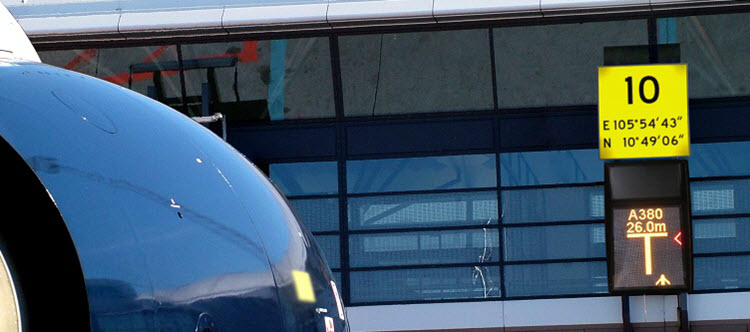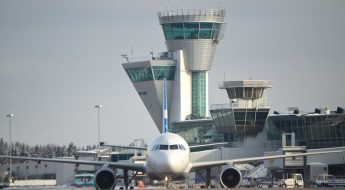
When integrated with airport systems and gate equipment, advanced visual docking guidance systems can deliver more predictable aircraft turnaround times, higher operational efficiency and safer gate areas than is possible with conventional docking guidance technology. Investing in higher operational efficiency will create more capacity within an airport’s existing infrastructure.
Integrating isolated airport control systems in the tower, at the gate and across the airfield is the most cost-effective way for airports to meet today’s traffic demand and future growth. Investing in higher operational efficiency will create more capacity within an airport’s existing infrastructure.
A critical element in this integrated environment is the Advanced Visual Docking Guidance System (A-VDGS), which brings essential new capabilities over and above those of a conventional VDGS. The result is increased safety and efficiency all the way from approach to departure.
So, what are these new functions and how do they help airports to reduce the cost of airport and airline operations?
Let’s start by looking at how a conventional VDGS works.
Going active for accurate docking every time
A VDGS visually indicates the positioning of an aircraft at a gate using basic and passive azimuth positioning and stop guidance. However, a passive VDGS does not know the position of the aircraft during the docking procedure, since it provides only passive guidance. Although it may be able to measure the distance to the aircraft, it cannot measure laterally and so does not know the aircraft’s exact position.
This means the accuracy of the guidance depends on the aircraft type, which can result in misleading information being presented during docking. Furthermore, a VDGS is rather inflexible as it does not allow re-alignment of centerlines and cannot cope with multiple centerline gates that support both narrow and wide body aircraft operations. And should there be an incident, the system will not be able to provide adequate information for a subsequent investigation.
On the other hand, as well as providing basic and passive azimuth and stop position information, an A-VDGS augments this with active guidance for pilots, using a 3D scanner which measures height, distance and lateral position. This allows the precise aircraft position to be detected within the gate and displays relevant and unambiguous information to anyone responsible for parking at the gate.
This more advanced 3D positioning technology enables much more accurate and flexible guidance, regardless of the aircraft type being docked. Guidance can now be given on how far off the centreline the aircraft is and the direction to correct the error, distance to the stop position, accurate indication of when to stop, and a warning if the aircraft goes beyond the stop position. This alone can create huge cost savings, with 25 percent of all gate related incidents involving passenger boarding bridges and the cost of a wide body jet out of service for one day being around 100,000 USD.
Integration improves safety and efficiency
The A-VDGS also fully supports Airport Collaborative Decision Making (A-CDM) and when integrated with other airport systems and gate equipment leads to more predictable aircraft turnaround, increased efficiency and higher airport profitability.
Full integration enables seamless guidance from the runway to the gate with full awareness for ATC, apron control and ground personnel. Safety is improved because the A-VDGS positioning system automatically feeds positional data from the gate area to surveillance systems. Not only does this mean controllers have a real-time view of the aircraft position, but they are automatically alerted if an aircraft tail is blocking the taxiway, with clear safety benefits.
Integration also provides accurate information on the turnaround process to apron control, the departure management system and air traffic controllers. This leads to improved predictability of departure sequencing and proactive control of traffic flow.
Furthermore, when the A-VDGS displays are not being used to dock aircraft, they can show real-time data on the target off block time (TOBT), countdown timers for specific actions, or other free text information vital to the operation. The A-VDGS display is clearly visible from the entire gate area, enabling personnel to synchronize their work to provide more efficient gate operations.
As airports strive to deal with ever growing passenger demand and traffic growth, integrating gate, tower and airfield systems is the smart investment to enhance airport safety and protect future profitability. The A-VDGS is a critical part at the heart of this integration.
ADB SAFEGATE is a leading provider of intelligent solutions that deliver superior airport performance from approach to departure. We partner with airports and airlines to analyze their current structures and operations, and jointly identify and solve bottlenecks. Our consultative approach enables airports to improve efficiency, enhance safety and environmental sustainability, as well as reduce operational costs. Our portfolio includes solutions and services that harmonize airport performance, tackling every aspect of traffic handling and guidance, from approach, runway and taxiway lighting, to tower-based traffic control systems and intelligent gate and docking automation. ADB SAFEGATE has 900+ employees in more than 20 countries and serves some 2,500+ airports in more than 175 countries.















Leave a Comment